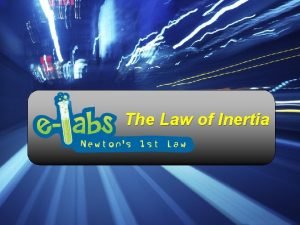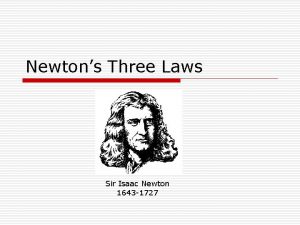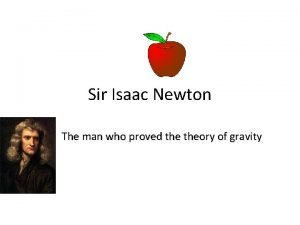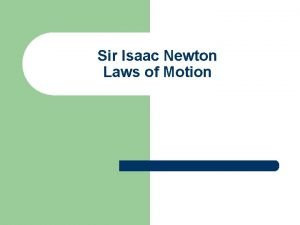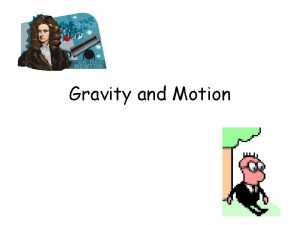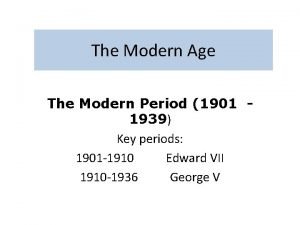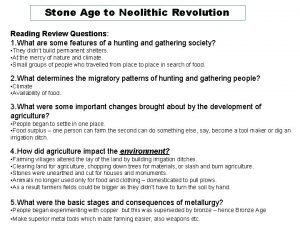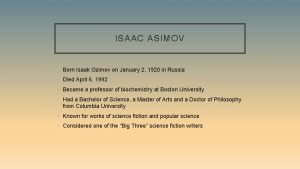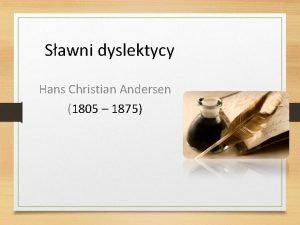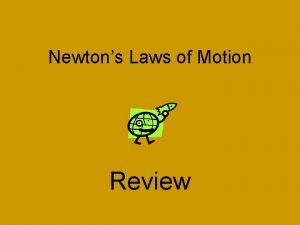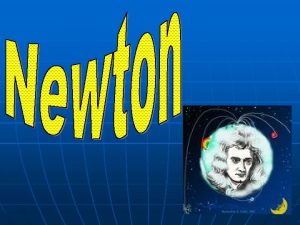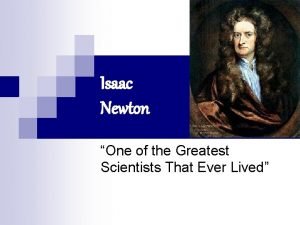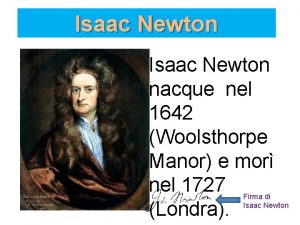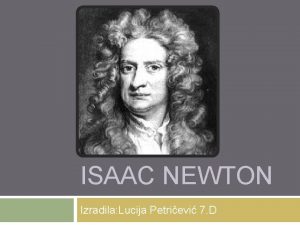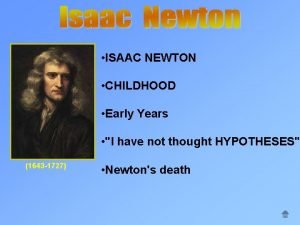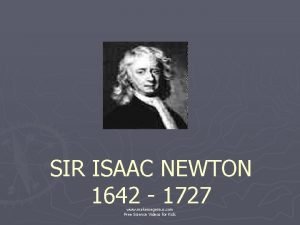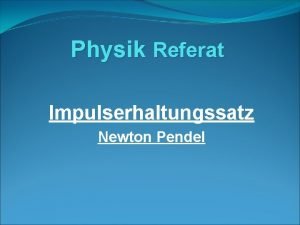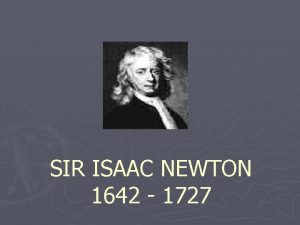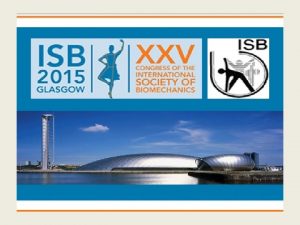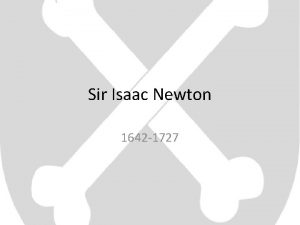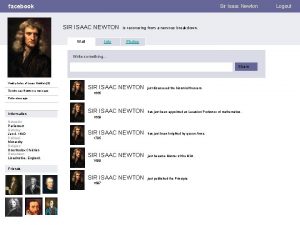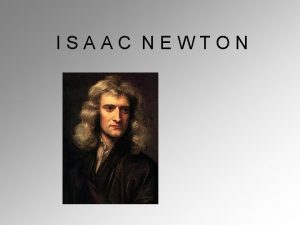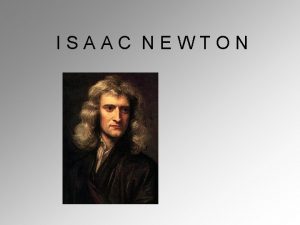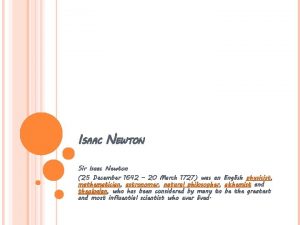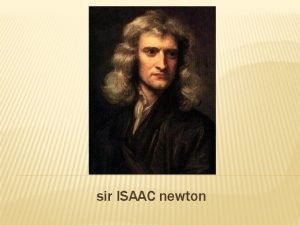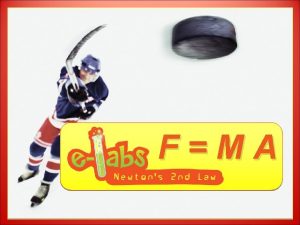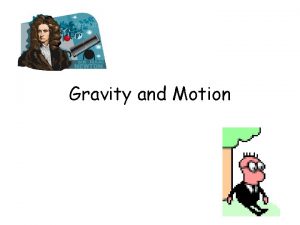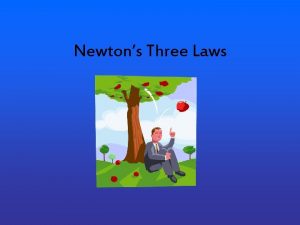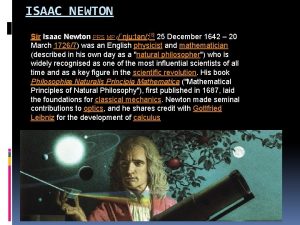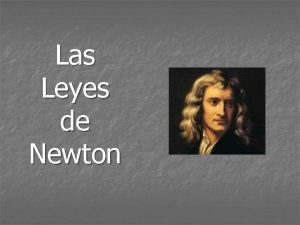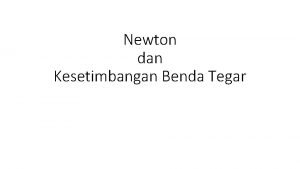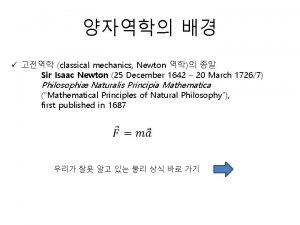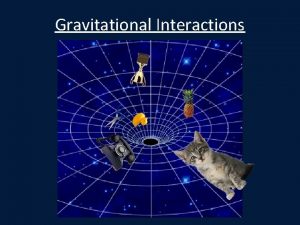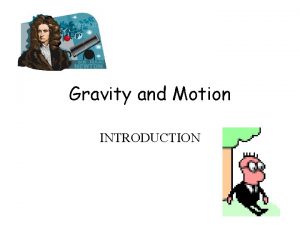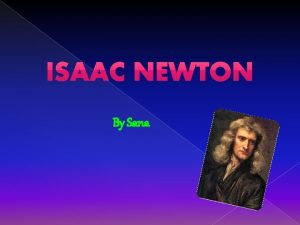Modern Age ISAAC NEWTON ISAAC NEWTON Sir Isaac



























- Slides: 27

Modern Age ISAAC NEWTON

ISAAC NEWTON Sir Isaac Newton English mathematician and physicist Birth: December 25, 1642 Death: March 20, 1727 Place of Birth: Woolsthorpe, England

ISAAC NEWTON

ISAAC NEWTON Known for: Inventing, in part, the branch of mathematics now known as calculus Formulating the three laws of motion, which describe classical mechanics Proposing theory of universal gravitation, which explains that all bodies are affected by the force called gravity

ISAAC NEWTON Career: 1661 Entered Trinity College, University of Cambridge 1665 -1666 Developed what he called the fluxional method (now known as calculus) while living in seclusion to avoid the plague 1669 -1701 Served as Lucasian Professor of Mathematics at the University of Cambridge

ISAAC NEWTON Career 1687 Published his seminal work, Philosophiae Naturalis Principia Mathematica (Mathematical Principles of Natural Philosophy), which contained his three laws of motion and theory of gravitation 1703 -1727 Acted as president of the Royal Society, an organization that promotes the natural sciences 1704 Published Opticks (Optics), describing his theory that white light is a blend of different colors

ISAAC NEWTON Did You Know: Newton was reluctant to share his research with other scientists for fear they would take credit for his discoveries. Newton instigated a Royal Society investigation to prove that he invented calculus before German mathematician Gottfried Wilhelm Leibniz, who had published the method first.

ISAAC NEWTON Did you know: In addition to science, Newton showed an interest in alchemy, mysticism, and theology. French writer Voltaire first recorded the story that a falling apple gave Newton the inspiration for his theory of gravitation. Voltaire cited Newton's niece as his source for the story.

NEWTON’S FIRST LAW MOMENTUM The First Law of Motion Everybody continues in a state of rest, or of uniform motion in a straight line, unless it is compelled to change that state by forces impressed upon it. Momentum Is a measure of this state of motion. A. Either an object in a state of rest. B. Or an object in a state of motion.

NEWTON’S FIRST LAW MOMENTUM Momentum of an object depend on its A. speed and B. amount of matter. Newton define momentum as proportional to velocity. Velocity is a description for both speed and the direction of motion. The constant (unvarying property) of the proportionality of momentum to velocity is mass.

NEWTON’S FIRST LAW MOMENTUM Mass – is a quantity that characterizes the total amount of material in the body. Mass – is the property that gives the body its inertia. That makes it resists motion. The first law states that the product of a body’s mass and velocity is constant if no outside force is applied to it.

NEWTON’S FIRST LAW MOMENTUM Newton’s first law states that the natural path for an object is not a circle but a straight line. Relating it now to the motion of celestial bodies, some force is required to bend the path of a planet from a straight line and force it to orbit the Sun.

NEWTON’S SECOND LAW – FORCE The Second Law of Motion Any change of motion is proportional to the force that acts, and it is made in the direction of the straight line in which that force is acting. Another way to state it will be if a force acts on a body, it produces a change in the momentum of the body that is in the direction of the applied force.

NEWTON’S SECOND LAW - FORCE The second law actually defines force. Force is a physical influence that tends to change the position of an object with mass And is equal to the rate of change in the momentum of the object. The magnitude or strength of a force is defined as the rate at which it produces a change in the momentum of the body on which it acts.

NEWTON’S SECOND LAW - FORCE Some familiar examples of forces: A. Pull of the Earth B. Friction of the ground C. Floor on the moving bodies. D. Impact of a bat on the baseball. E. Pressure exerted by air and F. Thrust of a rocket engine.

NEWTON’S SECOND LAW - FORCE The first law is consistent with the second: If there is no force, the change in momentum is zero. There three ways for how momentum can change because of application of force. A. Its velocity can change. B. Its mass can change. C. and Both velocity and mass can change. But usually momentum change results from a change of velocity.

NEWTON’S SECOND LAW - FORCE The vast examples could actually be explained by this formula: F = ma or Force is equal to mass times acceleration. Acceleration – is any change in velocity. It involves a change in A. speed B. direction C. or both.

NEWTON’S SECOND LAW – FORCE If the acceleration occurs in the same direction as the body then the body speeds up. If the acceleration occurs in the opposite direction to the velocity then the body slows down. If acceleration occurs exactly at right angles to the velocity, only the direction and not its speed changes.

NEWTON’S SECOND LAW - FORCE Examples of force application resulting to changes in acceleration of an object. A. Gravity accelerates a falling body in the same direction as it is heading so it speeds it up. B. Friction uniformly slowing down a certain object slid across a rough horizontal surface. Two equal accelerations may correspond to entirely different forces if the masses involved are different.

NEWTON’S THIRD LAW REACTION The Third Law of Motion To every action there is always an equal and opposite reaction; or, the mutual actions of two bodies upon each other are always equal and act in opposite directions. Or explained as, if a force is exerted on an object, it must be exerted by something else, and the object will exert an equal and opposite force back upon that something.

NEWTON’S THIRD LAW REACTION To demonstrate the concept of the third law we use baseball. In baseball the recoil of the bat shows that the ball exerts a force on the bat during the impact, just as the bat does on the ball. The momentum (measure of movement) imparted to the bat by the ball is transmitted through the batter to the Earth. So the acceleration of the bat is far less than that suffered by the ball.

NEWTON’S THIRD LAW - MOTION In the third law, a mutual force acts upon the two objects concerned. Each object always experiences the same total change of momentum, but in opposite directions. Momentum again is the product of velocity and mass, therefore the object with lesser mass will be the one end up with proportionately greater velocity.

NEWTON’S UNIVERSAL GRAVITATION Newton hypothesized that there is a universal attraction between all bodies everywhere in space. Within the solar system this gravitational force must act between the planets and the Sun. It then produces an acceleration called centripetal acceleration. The centripetal acceleration pulls each planet from a straight line and bend its path into an elliptical orbit.

NEWTON’S UNIVERSAL GRAVITATION The centripetal force exerted on the planet by the Sun must be in proportion to the planet’s mass and in inverse proportion to the square of the planets distance from the Sun. f is proportional to m/r 2 The planets force on the Sun will be f is proportional to M/r 2 The attractive force between the two bodies have the mathematical form f is proportional to m. M/r 2

The Law of Gravitation For Newton’s hypothesis of universal attraction to be correct, there must be an attractive force between all pairs of objects everywhere. This force is proportional to their masses of the two bodies and inversely proportional to their separation. It is describe the equation F = (G) (m. M/d 2)

The Law of Universal Gravitation G is the constant of gravitation. The value of G depends on the units of mass, distance and forced used. If we use metric units G is equal to 6. 67 x 10 -11 Nm 2/kg 2.

Prepared By: ZYBRINSKIE T. BANGCADO
 Inertia in life
Inertia in life What are the three newton's law of motion
What are the three newton's law of motion Newton's three laws
Newton's three laws Oppisite of sir
Oppisite of sir Isaac newton's laws
Isaac newton's laws Http://www.exploratorium.edu/ronh/weight/
Http://www.exploratorium.edu/ronh/weight/ Sublime gracia amazing grace español
Sublime gracia amazing grace español Victorian age and modern age
Victorian age and modern age Difference between stone age and modern age
Difference between stone age and modern age Iron age bronze age stone age timeline
Iron age bronze age stone age timeline Iron age bronze age stone age timeline
Iron age bronze age stone age timeline Sir isaac asimov
Sir isaac asimov Ciekawostki o andersenie
Ciekawostki o andersenie 3 laws of motion by isaac newton
3 laws of motion by isaac newton Idősebb isaac newton
Idősebb isaac newton Da rules meme
Da rules meme Wiktoria witkowska
Wiktoria witkowska Isaac newton one of the greatest scientists was born
Isaac newton one of the greatest scientists was born Woolsthorpe manor
Woolsthorpe manor Grób izaaka newtona
Grób izaaka newtona Isaac newton prezentacija
Isaac newton prezentacija Isaac newton lover
Isaac newton lover Isaac newton early childhood
Isaac newton early childhood Isaac newton color wheel
Isaac newton color wheel Isaac newton trivia
Isaac newton trivia Referat isaac newton
Referat isaac newton Ley de la inercia y el cinturón de seguridad
Ley de la inercia y el cinturón de seguridad Legea lui newton
Legea lui newton
